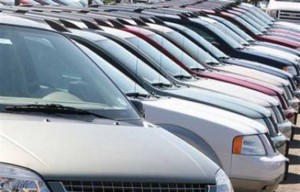
An AlixPartners study suggests that the frenetic auto sales pace of 2014 will begin to cool off in the near future.
Automakers and auto dealers better enjoy the good times while they last because new car sales are going to begin sliding after this year, with a serious drop off by 2017, according to a new study.
AlixPartners, a global business advisory firm, suggests automakers are going to get chance to prove they can make money while selling 12 million vehicles a year in the near future. The industry is tracking for a 16-million to 16.5-million unit sales year right now, but they predict that’s all going to come to an end.
“The good news is the global auto industry made it through the financial crisis, recession and a whole lot of pain,” said John Hoffecker, co-president of the Americas at AlixPartners. “The bad news is what’s ahead is uncertain and unprecedented, and could be painful as well.”
The firm believes that a projected rise in interest rates and a lack of interest in car ownership by the next generation of drivers – especially with the advent of car-sharing services – will combine to crimp sales, starting next year.
“The biggest factor would be this credit bubble, and without making an exact projection of when that will happen, that, to use is the window when you’ll see an impact on car sales,” said Dan Hearsch, a director in the automotive practice at AlixPartners. “The other side of it is cyclical and predictable. We’re a little more pessimistic because of these other factors.”
The steady growth of the auto industry has been unprecedented, the study notes, which suggests it isn’t sustainable. By the end of 2013, the industry posted year-over-year sales growth for five consecutive years: just the third time since the end of World War II that has happened.
The study also points to what is described as a “QE Bubble,” or a liquidity bubble underpinned by the Federal Reserve’s current quantitative-easing actions. Some of the “air” in that “bubble” may begin leaking as the Fed starts undoing some of those actions. If that occurs, a hike in interest rates, which have been hovering at record lows for several years now, would occur adding to the price of a new car or truck.
(Alleged murder underscores danger of leaving children in hot cars. For more, Click Here.)
If consumer interest rates were to rise three percentage points – about the normal historical increase when rates go up in a managed fashion after a prolonged downward trend – that would translate into $2,500 less purchasing power for car buyers, according to the study. If they were to rise seven points, which is far less than the rise in the early 1980s recession, that would mean $5,250 less purchasing power.
(Click Here for details about UAW’s new plan for organizing Volkswagen plant.)
“The auto industry in North America is in what you might call a ‘perfect calm’ right now, but this remains very much a cyclical industry,” said Mark Wakefield, managing director at AlixPartners and head of the firm’s Automotive Practice in the Americas, in a statement.
(To see more about TDB’s first drive in the 2015 Hyundai Sonata, Click Here.)
“If there’s a perfect unwinding of QE and its many international brethren, interest rates might rise moderately, which would likely dampen demand; but if it’s not done perfectly—and that’s a tall order – we could be looking at a steep sales downturn, and increased debt costs sooner than many are planning for.”

The survivors in the coming storm will be those can create products that generate “want” rather than “need.”
For too long, the manufacturers have had it too easy, selling 13-16 million units per year mostly to fill the market’s “need: for transportation.
Longer replacement cycles resulting from better quality vehicles and lower annual mileage are part of the problem, but so too is a younger generation no longer inclined to pursue the sort of independence we all found in our first cars.
Combating this declining market will require the manufacturers to move away from selling generic transportation appliances, and get back to selling achievable dreams.
Ford did a good job of this with the new Edge, packing tons of tech goodies into what would normally be a bread and butter model, and then enlisting social media to take that story to a demographic that would otherwise have little interest in a new car.
As for interest rates, the days of charging interest to anybody other than sub-prime borrower car-buyers are all but gone. Ford’s competition for a new Mustang is no longer the Camaro, but rather, a cruise-ship vacation, a new pool, or a home theater. As long as those competitors are surviving off of subsidized financing, 0% financing will also be the price of survival in the auto biz.
I just dropped another $1,800 into my 95 Lumina. I can’t sell it for less than $6,300 or I will be losing money. Even though it is “the old GM”, it will probably still be on the road when people can’t afford new.
While the youth buyers are not interested in new vehicles, they are also not interested in innovation. They are not innovative minded unless it comes to the next I-Phone or X-Box combat game. The day of technology waste lands has entered and the younger buyers are more interested in dropping their “earned” (didn’t say hard earned, just “earned) money into the newest I-Phone with all the bells a whistles. They don’t look up enough to be trusted to drive a vehicle. So until the car manufacturer’s ensure all vehicles come with auto pilot so our youth of today can continue the thumb jamming sessions while relying on their “vehicle” to get them from point A to point B and then order their happy meal for them, there will not be the sales we have come to know and enjoy.